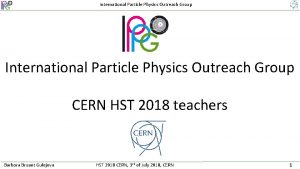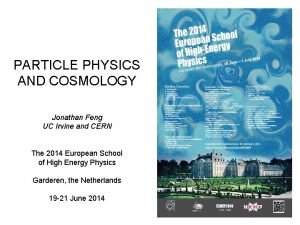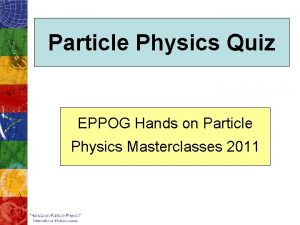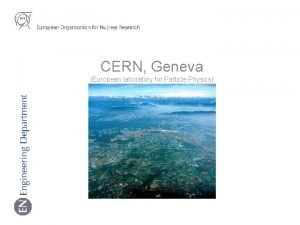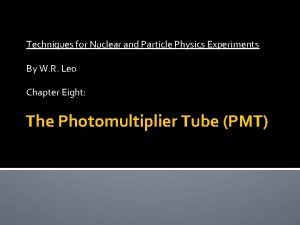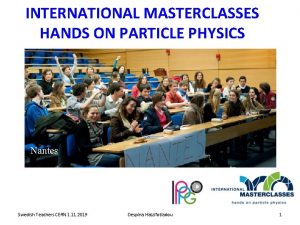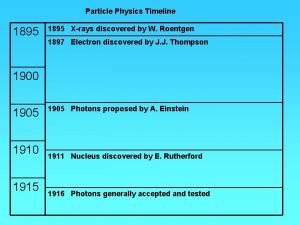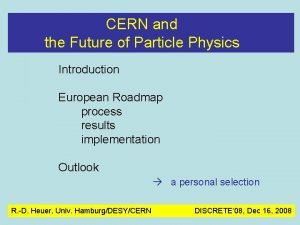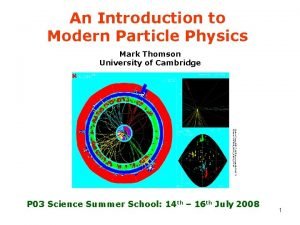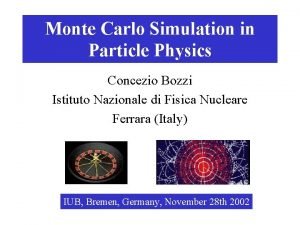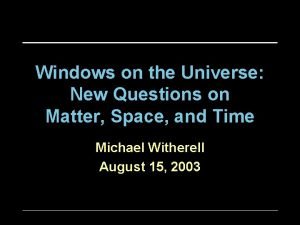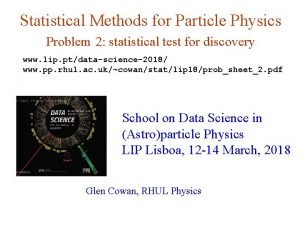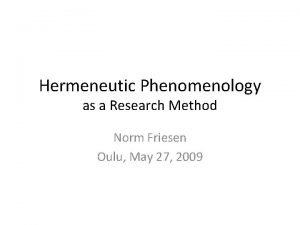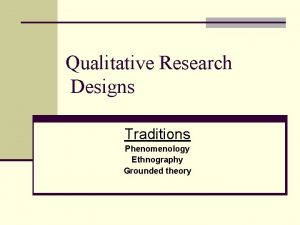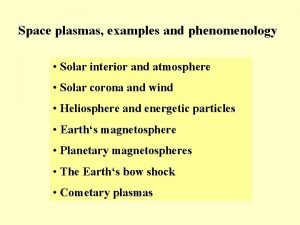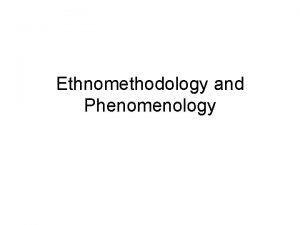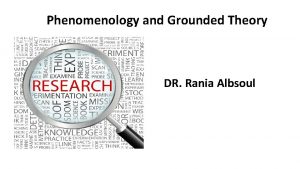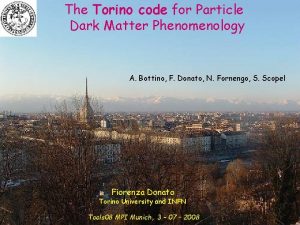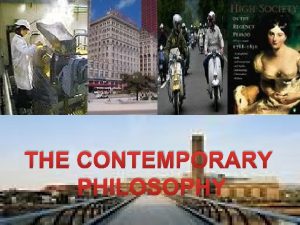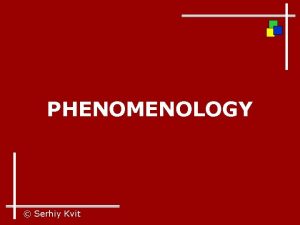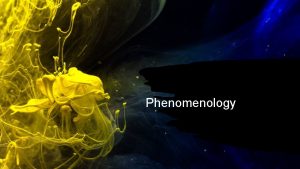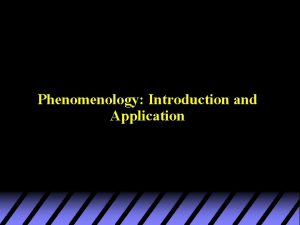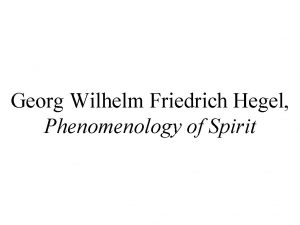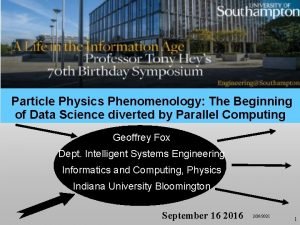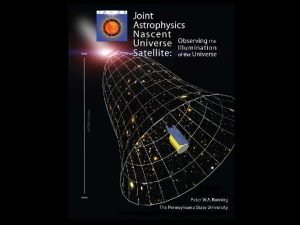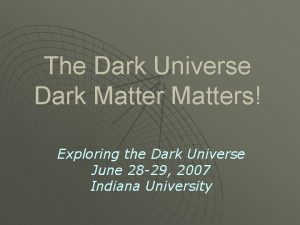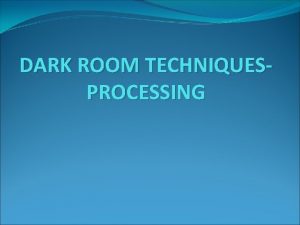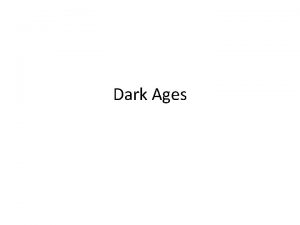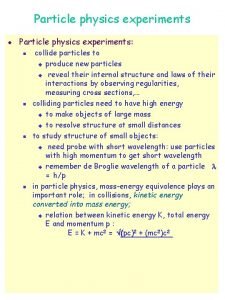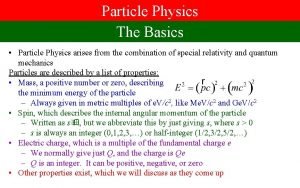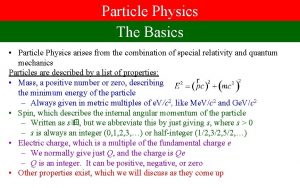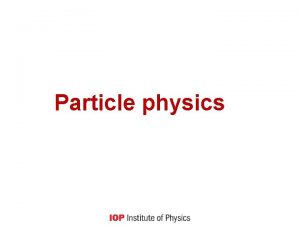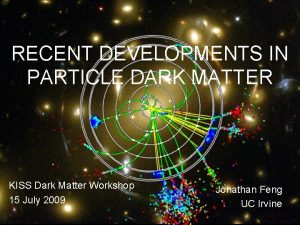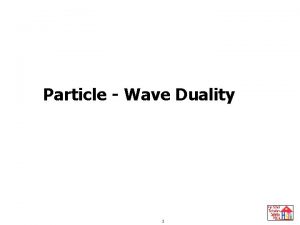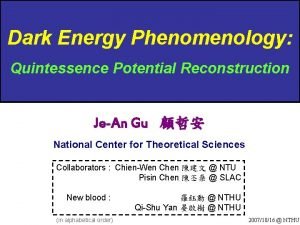MINIWORKSHOP ON PARTICLE PHYSICS PHENOMENOLOGY Understanding of Dark


























- Slides: 26

MINI-WORKSHOP ON PARTICLE PHYSICS PHENOMENOLOGY Understanding of Dark Energy - An Alternative Way Shih-Hao Ho (NTHU) 2006/06/06

Outline • Introduction • Some Dynamical Models for Dark Energy – Single Scalar Field • Quintessence • Phantom – Two Scalar Field • Quintom – One Complex Scalar Field • Spintessence • Hessence • Discussion

Introduction • From various observations such as SNe Ia, CMB, and Large Scale Structure formation, all tell us the compositions of the Universe is • picture taken from Wikipedia

• We also conclude that the Universe is spatially flat in large scale, and undergoing the accelerating expansion. • In order to accelerate the expansion, the equation-of-state parameter must have. • The simplest candidate is the cosmological constant for which , but its disadvantage is need a extreme fine tuning.

• But the parameter of dark energy might evolve from the dustlike ( at z~1) in the past to the phantomlike ( at z~0) today. • That’s why we need dynamical dark energy model. • What kinds of model do we have ?

Quintessence • Single real scalar field slowly rolling in its potential. • Consider the FRW metric and assume the field is homogeneous.

Phantom • A scalar field with opposite sign of kinetic energy to conventional sense. with • Of course, here we still assume

• However, A. Vikman has shown a no-go theorem which states it is impossible to cross the line as long as the following conditions are satisfied: (1) classical level, (2) GR is valid, (3) single real scalar field, (4) Lagrangian density only linearly depends on (5) Lagrangian density is continuous function and is differentiable enough (with respect to field ). • Therefore, if our goal is to make the dark energy evolve to cross the line, the simplest way is to consider two scalar field model.

Quintom (1) • Two scalar field with one quintessence type and the other phantom type which is proposed by Zhang et al. • when , when

Quintom (2) • We want the dark energy to evolve from to , that is, we require quintom evolve from quintessence dominated era to phantom dominated era. • If we only consider the simple quintom model without directly coupling between and , it might lead to the so-called Big Rip.

Big Rip • Under the phantom driving, the expansion of the Universe would become more and more violent, eventually the “repulsive” phantom energy overcomes the forces holding things together (e. g. gravity) , then rips it apart. This is the so –called Big Rip. Picture taken from New. Scientist. com

Spintessence (1) • A single complex scalar field spinning in a U(1) symmetric potential. • This internal U(1)-symmetric potential makes the motion of the scalar looks like one in the classical central potential. This causes a internal-angular-momentum barrier such that the field spirals slowly toward the minimum of the potential.

Spintessence (2) • Since the Lagrangian is invariant under , it has a conserved charge Q. It suffers from the problem of Q-ball formation except in some weird potential, for example, • Therefore, it might grow up and become either stable to be a dark matter candidate or decay into other particles.

Hessence (1) • A complex scalar field with a “non-canonical” form of Lagrangian proposed by Hao Wei et al. • Using , the kinetic energy term is • The kinetic energy term is just like the quintom model.

Hessence (2) • One can notice the Lagrangian is invariant under or equivalently , • If define , the above transformation becomes • It is obvious now why they call it “hessence”.

Hessence (3) • In terms of the parameter , the Lagrangian becomes • Again, assume the FRW metric and the homogeneity of field and , we can have the equation of motion • The 2 nd equation implies a conserved charge , here

Hessence (4) - hessence and Q-ball • Q-ball is a kind of non-topological soliton , which originally proposed by S. Coleman. • In his paper, he considered a two scalar field Lagrangian with SO(2) symmetry, the existence of Q-ball relies on this unbroken global symmetry. The Q-ball is stable and existent under (1) the limit of large Q , (2) has the minimum at some point , here

Hessence (4) - hessence and Q-ball (conti) • The hessence has no continuous global symmetry, hence we expect it free of Q-ball formation. • From the analysis of perturbation growth, they found the hessence is free from Q-ball formation if

Hessence (5) - hessence versus Big Rip • Wei and Cai found the hessence model with exponential potential and the power law potential can avoid the Big Rip problem. • Furthermore, Zhao and Zhang found that generally the Big Rip can be avoid in the hessence model from the analysis of plane of hessence model ( ).

Spintessence versus Hessence (1) • They both have internal symmetries; one is U(1) and the other is the so-called hyperbolic symmetry. • But they behaves quite differently because of the small difference of their equation of motion.

Spintessence versus Hessence (2) • For spintessence , conserved charge • For hessence, conserved charge

Spintessence versus Hessence (3) • Here we could notice two things. Firstly, both of them have a conserved charge in the same form. Second, the opposite sign before term. • They both have a conserved charge, why can only hessence be free of Q-ball formation ? • The crucial is the opposite sign before term.

Spintessence versus Hessence (4) • If we do the perturbation of the field, and seek for the solution • Spintessence • Hessence

Spintessence versus Hessence (5) • The instability band for the fluctuations is and for spintessence and hessence respectively. • The instability band for the spintessence can exists easily. On the contrary, if , the instability band do not exist. Therefore, Q-ball cannot be formed in hessence case

Discussion • It seems the non-canonical scalar field Lagrangian has diverse features and advantages in studying dark energy model. • The reason which causes the large different behavior between canonical and noncanonical type field is not just due to the kinetic term, but also the potential. • There might be some interesting features in this point we can study.

Reference • H. Wei, R. G. Cai and D. F. Zeng, Class. Quant. Grav. 22 3189 (2005) • H. Wei and R. G. Cai, Phys. Rev. D, 72 123507 (2005) • R. R. Caldwell, et al. , Phys. Lett. B 545 17 (2002) • Sidney Coleman, Nucl. Phys. B 262 263 (1985) • S. Kasuya, Phys. Lett. B 515 121 (2001) • W. Zhao and Y. Zhang, astro-ph/0604460 • R. R. Caldwell et al. , Phys. Rev. Lett. 91 071301 (2003) • R. R. Caldwell, Phys. Lett. B 545 23 • A. Vikman, Phys. Rev. D 71 023515 (2005) • S. M. Carroll et al. Phys. Rev. D 68 023509 (2003)
 In a dark dark town
In a dark dark town Dark matter and dark energy presentation
Dark matter and dark energy presentation Cern particle physics
Cern particle physics Form factor particle physics
Form factor particle physics Particle physics practice quiz
Particle physics practice quiz European laboratory for particle physics
European laboratory for particle physics Pmt particle physics
Pmt particle physics International masterclasses hands on particle physics
International masterclasses hands on particle physics Particle physics timeline
Particle physics timeline Cern particle physics
Cern particle physics Mark thomson particle physics
Mark thomson particle physics Concezio bozzi
Concezio bozzi Particle physics
Particle physics Particle physics
Particle physics Types of phenomenology
Types of phenomenology Phenomenology vs ethnography
Phenomenology vs ethnography What is phenomenology
What is phenomenology Phenomenology vs ethnography
Phenomenology vs ethnography Phenomenology research topics
Phenomenology research topics Phenomenology vs case study
Phenomenology vs case study Phenomenology and ethnography
Phenomenology and ethnography Phenomenology
Phenomenology Phenomenology examples
Phenomenology examples Strength and weaknesses of phenomenology
Strength and weaknesses of phenomenology Ethnomethodology and phenomenology
Ethnomethodology and phenomenology Phenomenology
Phenomenology Phenomenology vs grounded theory
Phenomenology vs grounded theory


